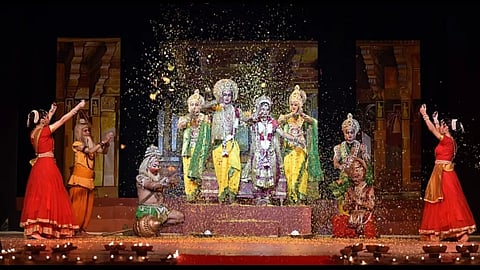After Geetanjali Shree became the first Indian to win the International Booker, a fresh discourse emerged on the status and role of translations. India has had a rich tradition of recreating and retelling its myths and legends. Not all retellings, however, find favour with politicians. In 2011, a 1987 essay by AK Ramanujan titled ‘300 Ramayanas: Five Examples And Three Thoughts On Translation’ was removed from the Delhi University syllabus following protests by the right-wing leaders. In the essay, Ramanujan drew readers’ attention to the disparate accounts of Ramayana that have existed across various cultures inside and outside India. He particularly used the examples of the Jaina Ramayana and the South Indian retellings of the Ramayana to draw comparisons. While Valmiki’s Ramayana has been largely accepted by some as the ‘original’, variations such as those in Kamban’s version or in tribal versions may leave many in the Hindi belt outraged and in denial. So what goes into translating mythological or religious texts like Ramayana that have such wide-ranging socio-political and cultural impact on a country?
Indian Mythology: Of Retellings And Translations
Noted translator of Indian myths, Arshia Sattar, speaks to Outlook’s Rakhi Bose on the art and politics of translating myths.
Noted translator of Indian myths, Arshia Sattar, speaks to Outlook’s Rakhi Bose on the art and politics of translating myths.
Is there a politics behind translating Indian mythologies? In a country where texts like Ramayana are considered holy and sacred and often used heavily as part of political discourse, what would you say are the challenges in front of translators?
I don't think there is a politics to the act of translation but retellings do. Most of the popular mythologies being written and read these days are retellings -- Neelakanthan, Amish, Pattanaik, Kane, Chandramouli, Divakaruni - these are all retellers. They use many sources for their stories and access many texts, often with the help of other scholars. And they pick an angle from which they want to tell their story. Some speak from the point of view of the antagonist, some from the position of women that have been silenced, some from a desire to establish the superiority of a character or an ideology or a theology. A translator has a single text and they tell you what that text says. You can't pick a politics when you translate, you have to stay with the text itself.
What are the problems faced by translators when dealing with mythological texts like Ramayana, and Mahabharata?
No more or no less than any other translators in terms of language. Ultimately, translation is about language. So we all face the same challenges and the same pleasures when we work.
It is said that the Hindi press's vernacular translations of mythological texts like Bhagwat Geeta and others (done by the likes of Geeta Press) helped the Hindu right in propagating a version of Hindu philosophy that may not necessarily be reflected in lesser dominant translations of the same work. Your comment?
Well, the Hindi presses speak only to the people who speak Hindi. There are so many other languages in India and the ideology of the so-called Hindu right is everywhere now. Let’s not mistake North India for the entire sub-continent. So whatever Gita Press and others might have done for the Hindi belt, there are clearly lots of other factors at work in the rest of the country.

In terms of myths, do translations, adaptations and retellings sometimes get mixed?
All the time. I think publishers and readers do not make enough of these distinctions -- all stories about the gods and heroes are presented as the 'real' thing, this is what the story is really about, when, in fact, translations are very very different. In a translation, you should not hear the translator's voice, in a retelling or an adaptation, the teller's voice is all-important, much like the voice of the traditional kathakar. I think it's unfortunate that all these different ways of presenting a story that is already known are bundled together rather thoughtlessly
What are the dominant languages in which Indian mythologies have been translated?
English, of course. And in the 18th and 19th centuries, German stands out as a West-European language. There were Dutch, Polish, and a few other East-European languages in the 20th century. All Indian languages tell their own versions of pan-Indian myths and epics, so we don't call those translations.
Do you think certain translations of the Ramayana and Mahabharata have been used to subvert the interpretations of the text to suit political will?
I don't think translations per se have done that, for all the reasons I mentioned above but retellings have. Besides, the translator's primary contract is with the text itself -- it's our job and our responsibility to present the text as it is, not as we think it is or as we would like it to be. But yes, I think retellings of the epics can be used to serve a political ideology.